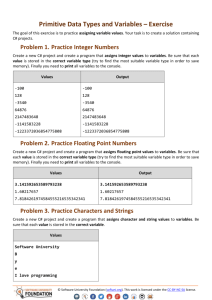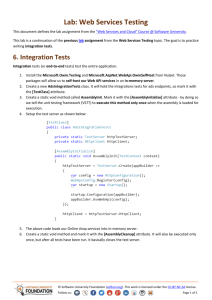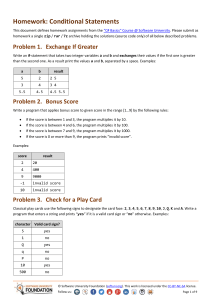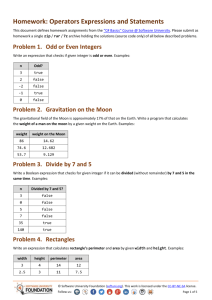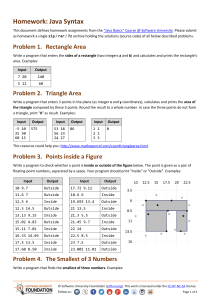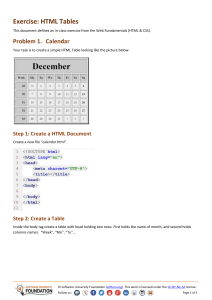C# Basics - Homework
advertisement
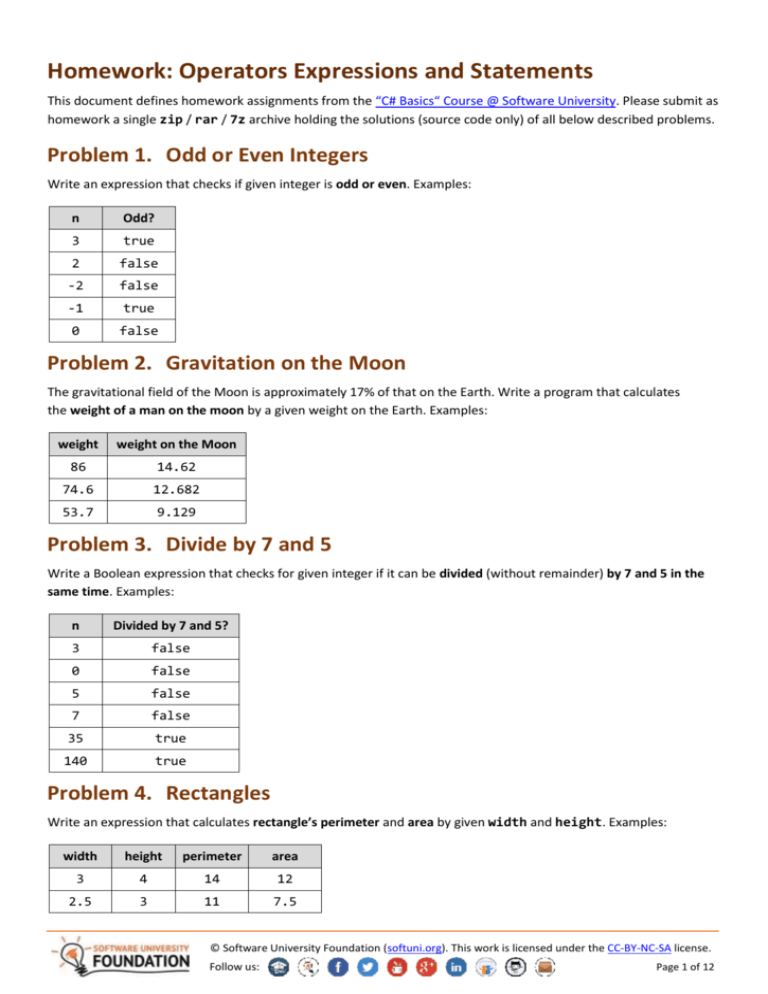
Homework: Operators Expressions and Statements
This document defines homework assignments from the “C# Basics“ Course @ Software University. Please submit as
homework a single zip / rar / 7z archive holding the solutions (source code only) of all below described problems.
Problem 1. Odd or Even Integers
Write an expression that checks if given integer is odd or even. Examples:
n
Odd?
3
true
2
false
-2
false
-1
true
0
false
Problem 2. Gravitation on the Moon
The gravitational field of the Moon is approximately 17% of that on the Earth. Write a program that calculates
the weight of a man on the moon by a given weight on the Earth. Examples:
weight
weight on the Moon
86
14.62
74.6
12.682
53.7
9.129
Problem 3. Divide by 7 and 5
Write a Boolean expression that checks for given integer if it can be divided (without remainder) by 7 and 5 in the
same time. Examples:
n
Divided by 7 and 5?
3
false
0
false
5
false
7
false
35
true
140
true
Problem 4. Rectangles
Write an expression that calculates rectangle’s perimeter and area by given width and height. Examples:
width
height
perimeter
area
3
4
14
12
2.5
3
11
7.5
© Software University Foundation (softuni.org). This work is licensed under the CC-BY-NC-SA license.
Follow us:
Page 1 of 12
5
5
20
25
Problem 5. Third Digit is 7?
Write an expression that checks for given integer if its third digit from right-to-left is 7. Examples:
n
Third digit 7?
5
false
701
true
9703
true
877
false
777877
false
9999799
true
Problem 6. Four-Digit Number
Write a program that takes as input a four-digit number in format abcd (e.g. 2011) and performs the following:
Calculates the sum of the digits (in our example 2+0+1+1 = 4).
Prints on the console the number in reversed order: dcba (in our example 1102).
Puts the last digit in the first position: dabc (in our example 1201).
Exchanges the second and the third digits: acbd (in our example 2101).
The number has always exactly 4 digits and cannot start with 0. Examples:
n
sum of digits
reversed
last digit
in front
second and third
digits exchanged
2011
4
1102
1201
2101
3333
12
3333
3333
3333
9876
30
6789
6987
9786
Problem 7. Point in a Circle
Write an expression that checks if given point (x, y) is inside a circle K({0, 0}, 2). Examples:
x
y
inside
0
1
true
-2
0
true
-1
2
false
1.5
-1
true
-1.5
-1.5
false
100
-30
false
0
0
true
0.2
-0.8
true
0.9
-1.93
false
1
1.655
true
© Software University Foundation (softuni.org). This work is licensed under the CC-BY-NC-SA license.
Follow us:
Page 2 of 12
Problem 8. Prime Number Check
Write an expression that checks if given positive integer number n (n ≤ 100) is prime (i.e. it is divisible without
remainder only to itself and 1). Examples:
n
Prime?
1
false
2
true
3
true
4
false
9
false
97
true
51
false
-3
false
0
false
Problem 9. Trapezoids
Write an expression that calculates trapezoid's area by given sides a and b and height h. Examples:
a
b
h
area
5
7
12
72
2
1
33
49.5
8.5
4.3
2.7
17.28
100
200
300
45000
0.222
0.333
0.555 0.1540125
Problem 10. Point Inside a Circle & Outside of a Rectangle
Write an expression that checks for given point (x, y) if it is within the circle K({1, 1}, 1.5) and out of the rectangle
R(top=1, left=-1, width=6, height=2). Examples:
x
y
inside K & outside of R
1
2
yes
2.5
2
no
0
1
no
2.5
1
no
2
0
no
4
0
no
2.5
1.5
no
2
1.5
yes
1
2.5
yes
-100
-100
no
© Software University Foundation (softuni.org). This work is licensed under the CC-BY-NC-SA license.
Follow us:
Page 3 of 12
Problem 11. Bitwise: Extract Bit #3
Using bitwise operators, write an expression for finding the value of the bit #3 of a given unsigned integer. The bits
are counted from right to left, starting from bit #0. The result of the expression should be either 1 or 0. Examples:
n
binary representation
bit #3
5
00000000 00000101
0
0
00000000 00000000
0
15
00000000 00001111
1
5343
00010100 11011111
1
62241
11110011 00100001
0
Problem 12. Extract Bit from Integer
Write an expression that extracts from given integer n the value of given bit at index p. Examples:
n
binary representation
p
bit @ p
5
00000000 00000101
2
1
0
00000000 00000000
9
0
15
00000000 00001111
1
1
5343
00010100 11011111
7
1
62241
11110011 00100001
11
0
Problem 13. Check a Bit at Given Position
Write a Boolean expression that returns if the bit at position p (counting from 0, starting from the right) in given
integer number n has value of 1. Examples:
n
binary representation of n
p
bit @ p == 1
5
00000000 00000101
2
true
0
00000000 00000000
9
false
15
00000000 00001111
1
true
5343
00010100 11011111
7
true
62241
11110011 00100001
11
false
Problem 14. Modify a Bit at Given Position
We are given an integer number n, a bit value v (v=0 or 1) and a position p. Write a sequence of operators (a few
lines of C# code) that modifies n to hold the value v at the position p from the binary representation of n while
preserving all other bits in n. Examples:
n
binary representation of n
p
v
binary result
result
5
00000000 00000101
2
0
00000000 00000001
1
0
00000000 00000000
9
1
00000010 00000000
512
15
00000000 00001111
1
1
00000000 00001111
15
© Software University Foundation (softuni.org). This work is licensed under the CC-BY-NC-SA license.
Follow us:
Page 4 of 12
5343
00010100 11011111
7
0
00010100 01011111
5215
62241
11110011 00100001
11
0
11110011 00100001
62241
Problem 15. * Bits Exchange
Write a program that exchanges bits 3, 4 and 5 with bits 24, 25 and 26 of given 32-bit unsigned integer. Examples:
n
binary representation of n
binary result
result
1140867093
01000100 00000000 01000000 00010101
01000010 00000000 01000000 00100101
1107312677
255406592
00001111 00111001 00110010 00000000
00001000 00111001 00110010 00111000
137966136
4294901775
11111111 11111111 00000000 00001111
11111001 11111111 00000000 00111111
4194238527
5351
00000000 00000000 00010100 11100111
00000100 00000000 00010100 11000111
67114183
2369124121
10001101 00110101 11110111 00011001
10001011 00110101 11110111 00101001
2335569705
Problem 16. ** Bit Exchange (Advanced)
Write a program that exchanges bits {p, p+1, …, p+k-1} with bits {q, q+1, …, q+k-1} of a given 32-bit unsigned
integer. The first and the second sequence of bits may not overlap. Examples:
n
p
q
k
binary representation of n
binary result
result
1140867093
3
24
3
01000100 00000000
01000000 00010101
01000010 00000000
01000000 00100101
1107312677
4294901775
24
3
3
11111111 11111111
00000000 00001111
11111001 11111111
00000000 00111111
2369124121
2
22
10
10001101 00110101
11110111 00011001
01110001 10110101
11111000 11010001
1907751121
987654321
2
8
11
-
-
overlapping
123456789
26
0
7
-
-
out of range
33333333333
-1
0
33
-
-
out of range
4194238527
Exam problems.**
All of the problems below are given from the previous C# Basics exam (26-Apr-2015-Morning). You are not
obligated to submit any of them in your homework. We highly recommend you to try solving some or all of them so
you can be well prepared for the upcoming exam. You need to learn how to use conditional statements, loops,
arrays and other things (learn in internet how or read those chapters in the book “Fundamentals of computer
programming with C#”). If you still find those problems too hard for solving it’s very useful to check and understand
the solutions. You can download all solutions and tests for this variant here or check all previous exams (scroll down
to the bottom of the page). You can also test your solutions in our automated judge system to see if you pass all
tests.
Problem 17. ** Book Problem
Stefan is a keen reader. He wants to read a programming book and wants to know exactly when he will finish it.
Every day in a given month he reads up some pages. Some days he goes camping and on these days he doesn’t
read.
© Software University Foundation (softuni.org). This work is licensed under the CC-BY-NC-SA license.
Follow us:
Page 5 of 12
You will be given the book’s page count, the number of camping days in a month and number of pages which
Stefan reads in a normal day, each on a separate line. Assume each month has 30 days and each year has 12
months. Calculate how many years and months Stefan will need in order to read the book and print the result on
the console in format “X years Y months”. If Stefan never reads the book, print “never”.
Note that if, for example, Stefan needs 3.1 months, you need to round that up – so you have to print “0 years 4
months”.
Input
The input will be read from the console. It consists of exactly three lines:
On the first line you will be given an integer – the number of pages of the book.
On the second line you will be given the number of camping days in a month.
On the third line you will be given the number of pages which Stefan reads every normal day.
The input will always be valid and in the format described, there is no need to check it explicitly.
Output
The output should be printed on the console.
On the only output line print the number of years and months Stefan will need to read the book in format
“X years Y months”.
If Stefan cannot read the book, you should print “never”.
Constraints
The number of pages of the book will be an integer in the range [1 … 2 000 000 000].
The number of camping days will be an integer in the range [0 … 30].
The number of pages Stefan reads in a normal day will be an integer in the range [0 … 100].
Allowed working time: 0.1 seconds. Allowed memory: 16 MB.
Examples
Input
Output
Comments
250000
5
10
83 years 4 months
There are 30 days in
25 normal days. On
25*10 = 250 pages.
read.
250000/250 = 1000 –
This is 83 years and
Input
Output
25
30
100
never
Input
24
0
1
a month => 5 camping days and
a normal day he reads 10 =>
On a camping day he doesn’t
he needs exactly 1000 months.
4 months.
Output
0 years 1 months
© Software University Foundation (softuni.org). This work is licensed under the CC-BY-NC-SA license.
Follow us:
Page 6 of 12
Problem 18. ** Chessboard Game
Goshko is a keen chess player. One day he was bored with his work and decided to take a break and create a game
using the chessboard. He takes a string, e.g. "Software University_2345", converts its symbols to numbers through
their ASCII codes and fills a chessboard with them. He takes the values of capital and small letters and digits only.
The value of any other symbol is zero. He fills the board’s squares with the numbers, from left to right and from top
to bottom (see the example below). The size of the chessboard is n*n (e.g. n = 5) and it always starts with a black
square. N will always be an odd number.
S
a
n
s
2
o
r
i
i
3
f
e
v
t
4
t
e
y
5
w
U
r
_
83
97
110
115
50
111
114
105
105
51
102
101
118
116
52
116
0
101
121
53
119
85
114
0
0
Let’s assume that there are two competing teams: the black team and the white team. Every team’s score is the
sum of the values in its squares. However if a square contains a capital letter its value should be given to the
opposing team. In the example above the scores are calculated as follows:
White Team Score = 83 'S' + 111 'o' + 116 't' + 97 'a' + 101 'e' + 105 'i' + 101 'e' + 115 's' + 116 't' + 51 '3' + 53 '5' = 1049
Black Team Score = 102 'f' + 119 'w' + 114 'r' + 85 'U' + 110 'n' + 118 'v' + 114 'r' + 105 'i' + 121 'y' + 50 '2' + 52 '4' = 1090.
Input
The input data should be read from the console.
The first line holds the size n of the chessboard.
The second line holds the input string.
The input data will always be valid and in the format described. There is no need to check it explicitly.
Output
The output should be printed on the console.
The first output line holds the winning team in format: “The winner is: {name} team”.
The second line holds the difference between the scores of the winning and the losing team.
In case the score is equal, print “Equal result: {points}”. Do not print the difference in this case!
Constraints
The number n will be an odd integer in the range [1 … 9].
Allowed working time for your program: 0.1 seconds. Allowed memory: 16 MB.
Examples
Input
Output
5
Software University_2345
The winner is: black team
41
© Software University Foundation (softuni.org). This work is licensed under the CC-BY-NC-SA license.
Follow us:
Page 7 of 12
Input
Output
3
aa
Equal result: 97
Problem 19. ** King of Thieves
Once upon a time there was a kingdom and everyone in the kingdom was a thief. Izzy wanted to become the King of
Thieves and so started stealing only perfect gems from other thieves. Help Izzy by showing him what a perfect gem
with given parameters should look like.
Input
The input data should be read from the console.
The first line will hold the size of the gem – n.
The second line will hold the type of the gem – a symbol: e.g. ‘*’.
The input data will always be valid and in the format described. There is no need to check it explicitly.
Output
The output should be printed on the console. It should consist of ‘n’ lines, holding the gem.
Constraints
The number n will be a positive odd integer between 3 and 59, inclusive.
The type of the gem will be a symbol from the standard ASCII table.
Allowed working time for your program: 0.1 seconds.
Allowed memory: 16 MB.
Examples
Input
Output
Input
Output
Input
Output
5
*
--*--********
-***--*--
7
@
---@----@@@--@@@@@@@@@@@@
-@@@@@--@@@----@---
13
a
------a----------aaa--------aaaaa------aaaaaaa----aaaaaaaaa--aaaaaaaaaaaaaaaaaaaaaaaa
-aaaaaaaaaaa--aaaaaaaaa----aaaaaaa------aaaaa--------aaa----------a------
© Software University Foundation (softuni.org). This work is licensed under the CC-BY-NC-SA license.
Follow us:
Page 8 of 12
Problem 20. ** Decrypt the Messages
You are working for a company which is very concerned about its information and communication. For this reason,
they have invented an internal approach to communication between different departments – they are
communicating to each other via messages, which are reversed (written backwards) and then encrypted. In order
to be read and understood, each message has to be decrypted. Your task is to write a program, which receives all
encrypted messages in a specific communication, decrypts them and prints all decrypted messages at the console
as well as the total number of messages that have been received.
At the beginning of a communication, you will receive either the keyword “START” (upper case) or “start” (lower
case), which indicates that you will start receiving reversed and encrypted messages. At the end of the
communication, you will receive either the keyword “END” (upper case) or “end” (lower case), which indicates that
the communication is over and you need to show the decrypted messages’ content and total count. Any nonempty string between the “start” and “end” keywords is considered a message. If no messages have been received
between the “start” and the “end” keywords, you should print on the console: “No message received.”
All messages are case-sensitive and consist of letters, digits, as well as some special characters – ‘+’, ‘%’, ‘&’, ‘#’ and
‘$’. Letters from A to M are converted to letters from N to Z (A N; B O; … M Z) and letters from N to Z are
converted to letters from A to M (N A; O B; … Z M). The converted letter should keep the case of the
original letter. The special characters are converted in the following way: ‘+’ is converted to a single space (‘ ’), ‘%’
is converted to a comma (‘,’), ‘&’ is converted to a dot (‘.’), ‘#’ is converted to a question mark (‘?’) and ‘$’ is
converted to an exclamation mark (‘!’). The digits (0-9) are not converted and stay the same.
For example, you receive the following message – “$1+rtnffrz+greprF” and you start decrypting it. Convert the 1st
character ‘$’ to ‘!’, then the 2nd character – ‘1’ stays the same, then covert the 3rd character – ‘+’ to single space ‘ ’, ‘r’
’e’, ‘t’ ‘g’, ‘n’ ‘a’, ‘f’ ‘s’, ‘f’ ‘s’, ‘r’ ’e’ , ‘z’ ’m’, ‘+’ ‘ ’, ‘g’ ‘t’, ‘r’ ’e’ , ‘e’ ’r’ , ‘p’ ’c’ , ‘r’
’e’ , ‘F’ ’S’. After decrypting all letters, the message is: “!1 egassem terceS” and when you reverse it, you get the
original message: “Secret message 1!”
Input
The input data should be read from the console. The input will contain a random number of lines. The line that holds
the keyword “START” or “start” will always be before the line that holds the keyword “END” or “end”. The input
data will always be valid and in the format described. There is no need to check it explicitly.
Output
The output data should be printed on the console.
On the first line print the total number of messages that have been received in format: “Total number of
messages: N” – where N is the number of received and decrypted messages.
On the next N lines print the decrypted messages.
If no messages have been received between the “start” and the “end” keywords, you should print on the
console only one line holding: “No message received.”
Constraints
The number of messages between the “start” and the “end” keywords will be between 0 and 100.
The length of each message will be between 1 and 1000 symbols.
© Software University Foundation (softuni.org). This work is licensed under the CC-BY-NC-SA license.
Follow us:
Page 9 of 12
Each encrypted message will contain only Latin letters, digits and the special symbols described above.
Allowed working time: 0.1 seconds. Allowed memory: 16 MB.
Examples
Input
Comments
Output
START
$$$byyrU
END
We start conversion from the 1 st Total number of messages: 1
character: $ !, $ !, $ !, b Hello!!!
o, y l, y l, r e, U H
and reverse the newly received string
“!!!olleH” to the original message
“Hello!!!”
Input
Comments
start
tsrqpon
1rtnFFrz
end
We start conversion from the 1 st Total number of messages: 2
character: t g, s f, r e, q abcdefg
d, p c, o b, n a and meSSage1
reverse the newly received string
“gfedcba” to the original message
“abcdefg”.
Then we do the same for the second
message.
Input
Comments
Output
start
There is no message received.
No message received.
Output
END
Input
Normal communication message.
START
$rtnffrz+tavjbyybs+rug+gclepar+bg+leg+%rfnryC
end
Output
Total number of messages: 1
Please, try to encrypt the following message!
© Software University Foundation (softuni.org). This work is licensed under the CC-BY-NC-SA license.
Follow us:
Page 10 of 12
Problem 21. ** Bits at Crossroads
Bits are usually very boring. They walk only left <-> right and up <-> down. Your task is to write a program which
builds diagonal roads to break the monotonous bits’ habits.
You are given a square board of bits (size NxN). Bit positions on each line are counted from right to left. Line
numbers are counted from top to bottom. Initially all bits are set to zero. You can build two diagonal roads easily if
you know the coordinates of the roads’ intersection (line number, bit position). A crossroad is an intersection
between two roads.
Example: The line number is 2 and the bit position is 5: (2, 5). There are two diagonal roads – from (0, 7) to (7, 0) and
from (0, 3) to (4, 7) and one crossroad (2, 5) (see Fig. 1). Cells shaded grey are the roads and cells shaded black are
crossroads.
Example 2: We have two predefined crossroads (2, 5) and (3, 2). Now there are 4 crossroads in total – the start
points and two additional points (1, 4) and (4, 3) (see Fig. 2).
Your task is to write a program that prints the integer representation of each row from the final board and finds the
number of crossroads on the board.
Fig. 1
0
1
2
3
4
5
6
7
7
1
0
0
0
1
0
0
0
Fig. 2
6
0
1
0
1
0
0
0
0
5
0
0
1
0
0
0
0
0
4
0
1
0
1
0
0
0
0
3
1
0
0
0
1
0
0
0
2
0
0
0
0
0
1
0
0
1
0
0
0
0
0
0
1
0
0
0
0
0
0
0
0
0
1
Number
136
80
32
80
136
4
2
1
0
1
2
3
4
5
6
7
1
0
0
0
1
0
0
6
0
1
0
1
0
0
0
5
1
0
1
0
0
0
1
4
0
1
0
1
0
1
0
3
1
0
1
0
1
0
0
2
0
0
0
1
0
1
0
1
0
0
1
0
1
0
1
0
0
1
0
0
0
1
0
Number
168
81
42
84
138
21
34
7
0
1
0
0
0
0
0
1
64
Input
On the first line, you are given an integer number N that represents the size of the board.
Each of the next lines will hold the position of a predefined crossroad – two integer numbers, separated
with a single space:
o The first integer will be the line number.
o The second integer will be the bit position.
When you read the “end” command from the console print the result.
The input data will always be valid and in the format described. There is no need to check it explicitly.
Output
The output data must be printed on the console.
On the first N lines print the integer representations of each row of the board.
On the last line print the total count of all crossroads on the board.
© Software University Foundation (softuni.org). This work is licensed under the CC-BY-NC-SA license.
Follow us:
Page 11 of 12
Constrains
The size N of the board is an integer in the range [3 ... 32].
Each start point will always be a zero bit.
Each start point will always be a valid crossroad - the line number and bit position will both be in the
range [0 … N).
Examples
Input
Output
Input
Output
Input
Output
8
2 5
3 2
end
168
81
42
84
138
21
34
65
4
10
3 1
0 1
5 2
end
146
77
45
19
47
76
154
305
608
192
4
16
2 5
3 2
8 5
12 3
end
41128
20561
10282
5205
2698
1301
682
1361
2208
4433
8874
17684
35338
5141
10274
20545
14
© Software University Foundation (softuni.org). This work is licensed under the CC-BY-NC-SA license.
Follow us:
Page 12 of 12
